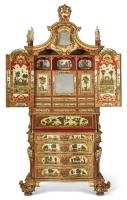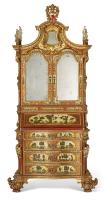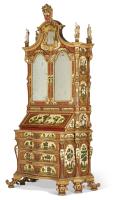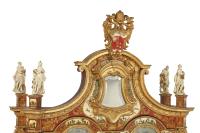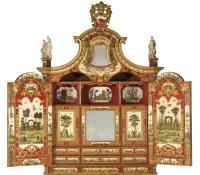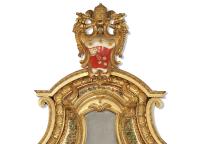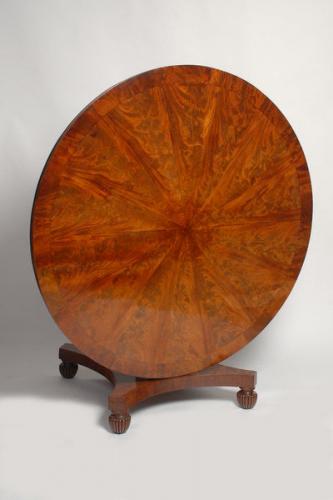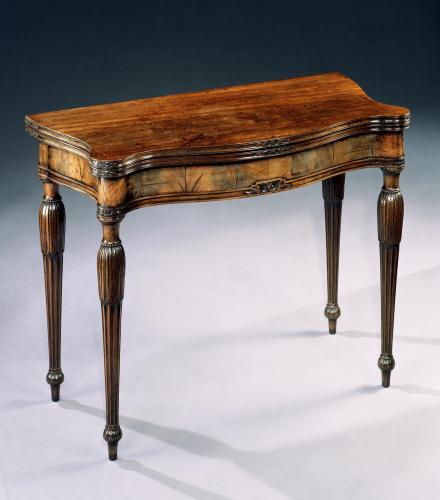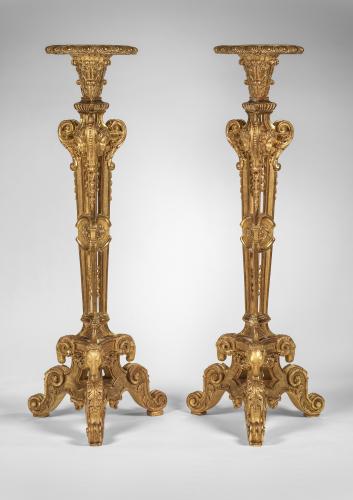
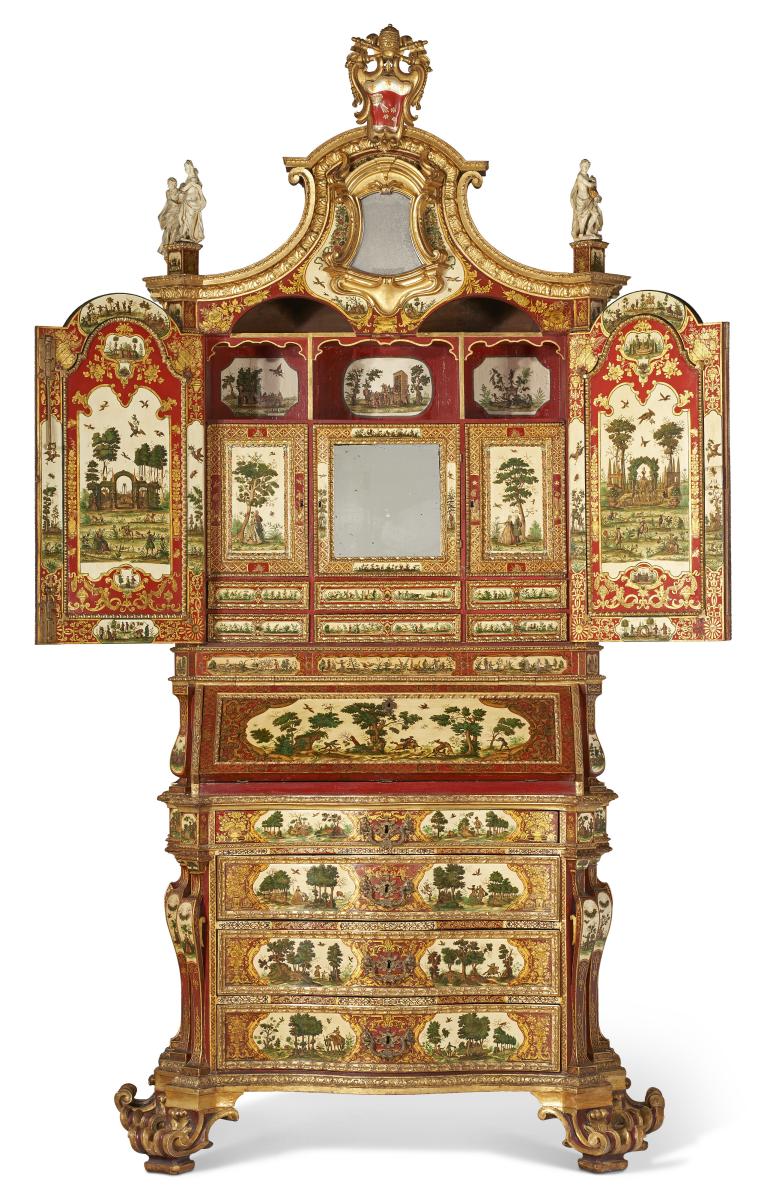
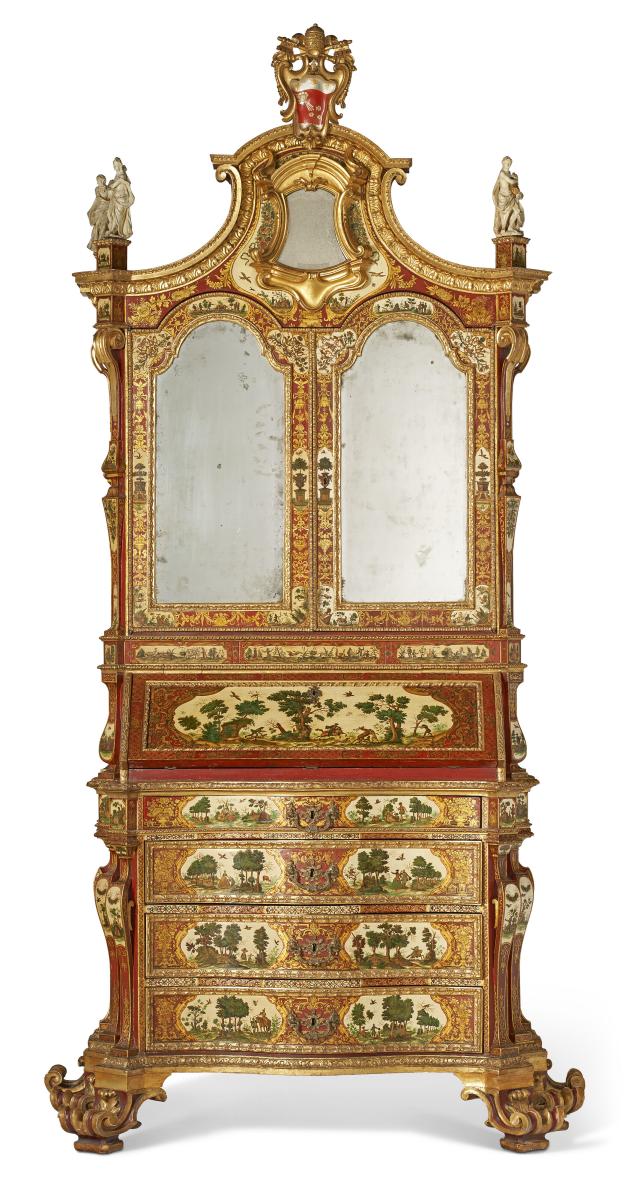
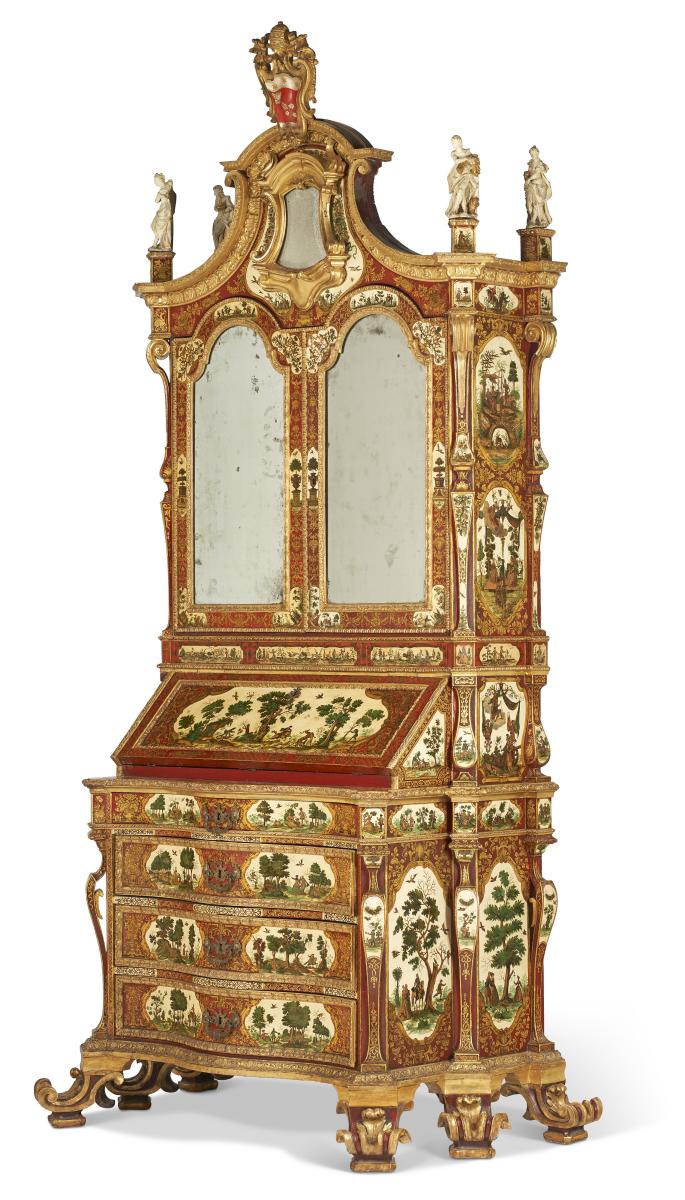
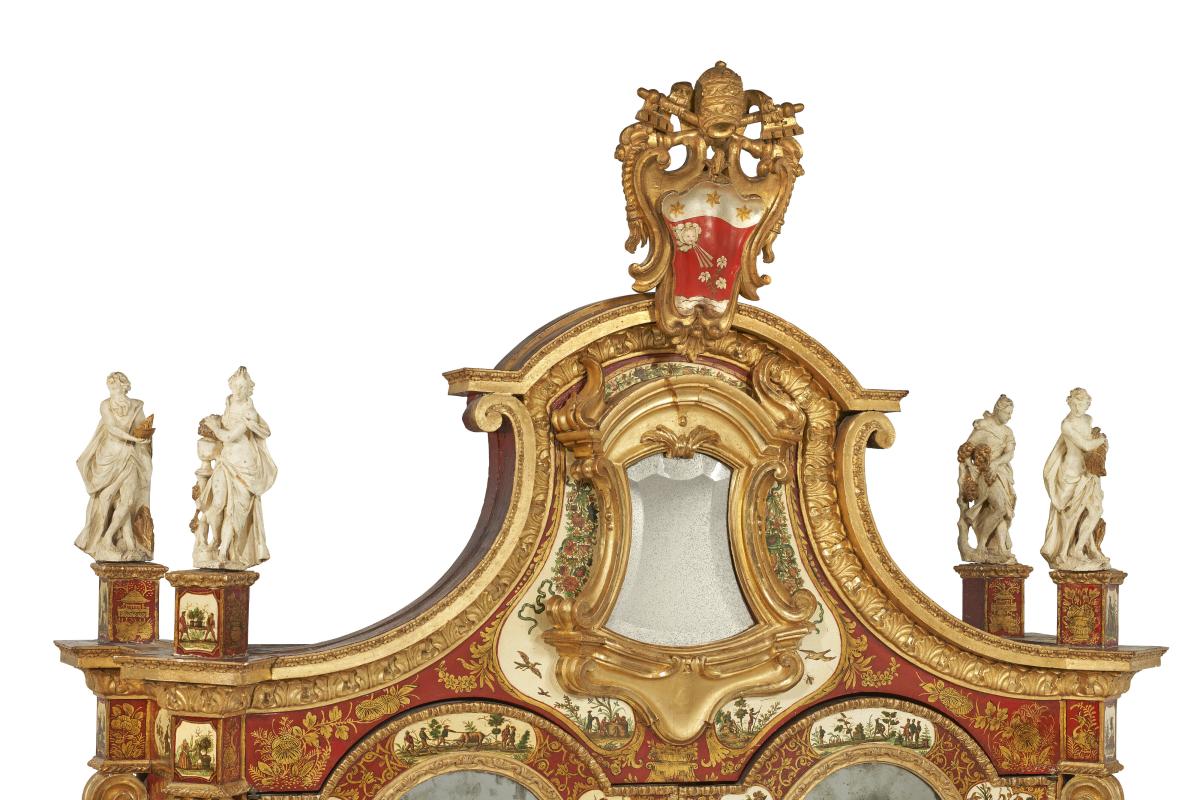
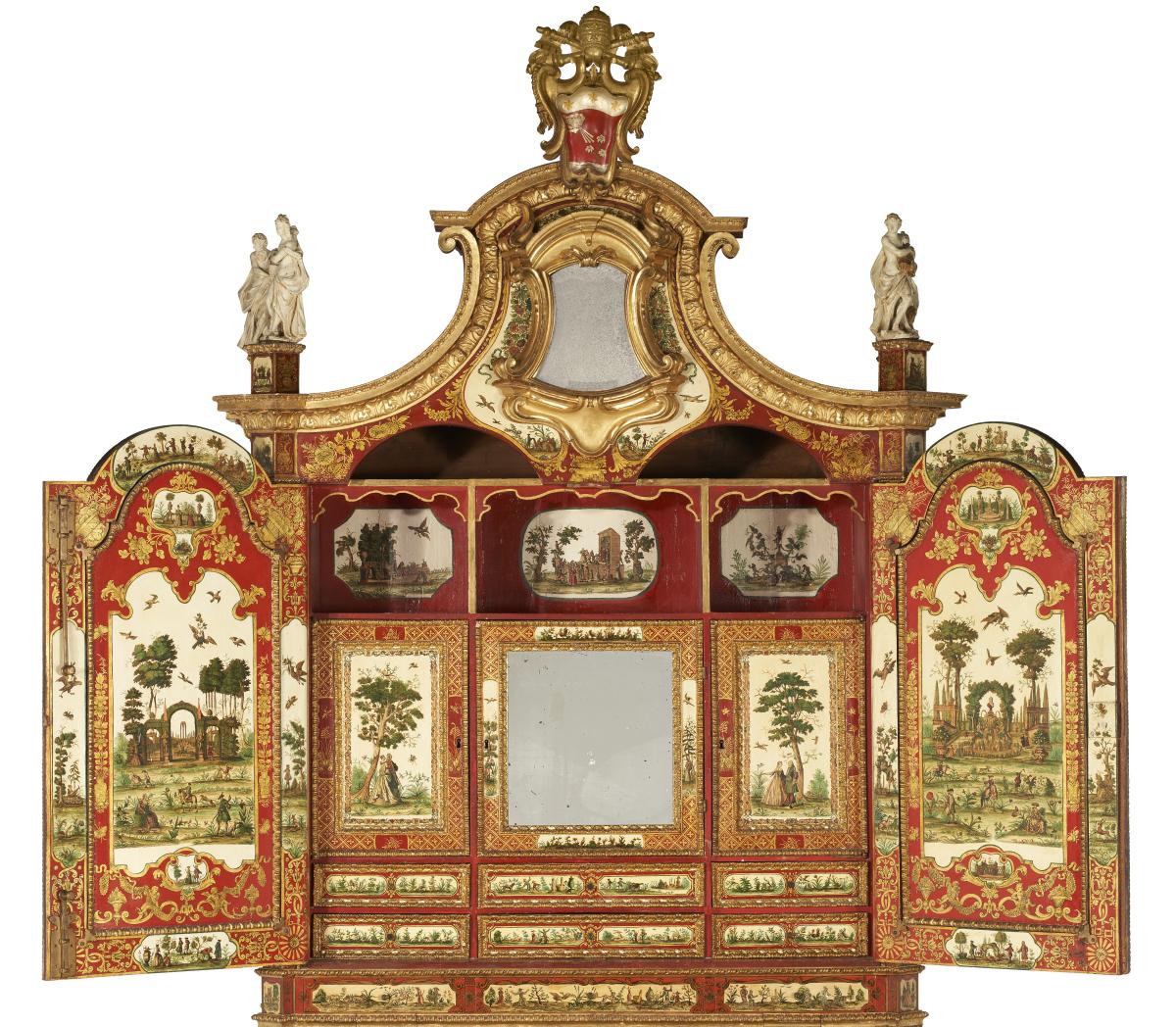
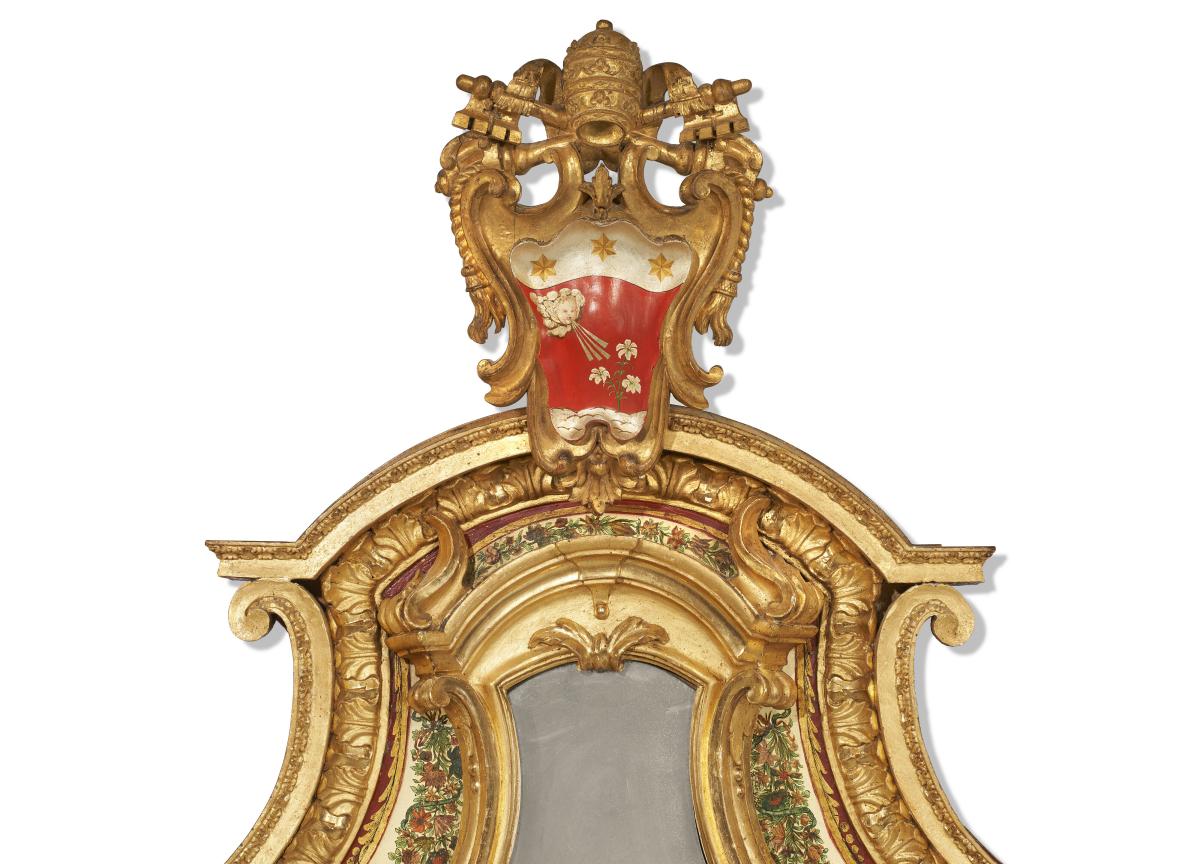
Price on application
This object is eligible for a Certificate of BADA Provenance
The BADA Standard
- Since 1918, BADA has been the leading association for the antiques and fine art trade
- Members are elected for their knowledge, integrity and quality of stock
- Our clients are protected by BADA’s code of conduct
- Our dealers’ membership is reviewed and renewed annually
- Bada.org is a non-profit site: clients deal directly with members and they pay no hidden fees
An Exceptional Italian Parcel-Gilt Red and Cream-Japanned and Lacca Povera Bureau Cabinet Circa 1740.
In two parts; the upper part with a scrolled arched cornice cantered by a mirrored panel and surmounted by a cartouche enclosing the insignia of Pope Pius VI, the corners fitted with figures representing the four seasons, above a pair of arched mirrored cupboard doors opening to reveal a mirrored door, flanked by a pair of doors, all beneath three pigeonholes and above an arrangement of later-added short drawers; the lower part with a slant front opening to reveal three pigeonholes above one convex and two concave- fronted drawers; above four long serpentine drawers fitted with gilt-metal handles and keyhole escutcheons, the canted corners and sides with shaped pilasters continuing to out scrolled acanthus leaf-carved feet; the whole decorated in lacca povera incorporating landscapes, hunting scenes, varicoloured birds and animals on cream reserves and a red lacquered ground highlighted with gilding, the cresting later painted.
Provenance
Ducs de Grimaldi, by repute and possibly given to Pope Pius VI
Maillat Collection,
Anonymous sale; Sotheby's, London, 30 November 1984, lot 290.
The Collection of Roberto Polo; Sotheby's, New York, 3 November 1989, lot 90.
With Pelham Galleries, London.
With Partridge Fine Arts, London.
Ann and Gordon Getty in 1993.
The first Duc de Grimaldi (1710 – 1789) was of Genoese descent whose father was a Senator of the Republic of Genova. He became a Spanish Diplomat and politician and after extensive experience as an Ambassador, Grimaldi served as Chief Minister of Spain between 1763 and 1776 helping to rebuild Spanish power following its defeat during the Seven years war. In 1776 he was removed from office and made Ambassador in Rome one year after Pope Pius VI became the Pope in 1775.
Exhibited
London, The Grosvenor House Antiques Fair, 1990 (with Pelham Galleries).
Literature
F. de Dampierre, The Best of Painted Furniture, New York, 1987, p. 59. M. Agnellini, Mobili Italiani del Settecento, Milan, 1990, p. 109.
M. Riccardi-Cubitt, The Art of the Cabinet, London, 1992, pl. 55, p. 104.
The Art of Arte Povera
This spectacular bureau cabinet is decorated throughout with the innovative technique of cutting up polychrome-decorated prints to imitate the visual effects of lacquer, known variously as lacca povera, arte povera, or lacca contrafatta. This technique involved laying prints on a generally light colored ground, often pale blue, yellow or white, which was then covered with a specific yellowish varnish called sandracca. The interest of the sandracca was to simulate the shiny and glossy surface of Asian lacquer while attenuating the contrast of the glued printed vignettes. With time, the multiple layers of sandracca would turn slightly darker and create an intricate network of fine craquelure which can be seen under close examination. On this cabinet the printed scenes, which vary from extravagant rocailles, to hunting scenes and Watteauesque pastorales, are all set on an ivory white ground within a ruby red framework, which, combined with the highly sculptural overall form and giltwood accents, provide a tremendously rich visual scheme. In Italy, the birthplace oflacca povera, the inspiration for this type of decoration originated from the intense commercial exchanges that port cities like Venice and Genoa entertained with Asia throughout the seventeenth and eighteenth centuries, with every type of lacquered goods being imported from both Japan and China. Although Venice, with its extensive trading contacts with the East, was one of the first cities in Italy, and in Europe, to produce imitations of Asian lacquer and pioneered the manufacture of various faux lacquerwares in order to produce a more affordable version of the rare and extremely expensive oriental import, every region of Italy had its own distinctive tradition of producing japanned furniture and several centers for the production of arte povera by so-called laccatorisoon flourished in various cities to satisfy growing demand for this lacquer work. Italian imitation lacquer eventually became a substitute to not only its Asian counterpart, but it also proved more time and cost effective than the traditional lacquer work performed in other European centers such as Berlin, Dresden, and Paris.
Roman Origins
Comparable polychrome and arte povera-decorated bureau cabinets were produced in a number of Italian regions, such as Veneto and Lombardy, see M. Agnellini, Mobili Italiani del Settecento, Milan, 1990, pp. 100, 109, and 84, respectively. Although the lacca povera of this cabinet is similar to the decoration of these North Italian works, certain characteristics of this cabinet suggest Rome as a place of manufacture, where, by the eighteenth century, painted furniture had a long-standing tradition and thus the fashion for lacca and lacca povera decoration was quickly embraced as illustrated by a polychrome-painted and lacquered cabinet and an inginocchiatoio, see A. González-Palacios, Fasto Romano, Rome, 1991, figs. LI and LIV, respectively. A further polychrome-painted Roman cabinet by Sebastiano Conca with similar pilasters is illustrated A. González-Palacios. Il Tempio del Gusto, Vol. II, Milan, 1984, p. 97. On this cabinet the relatively simple outline of the cresting is less exuberant than those found on contemporaneous Rococo pieces made in Genoa, Venice, and Milan; other major centers of lacca povera production. The highly pronounced, undulating, voluted and pierced corner and side pilasters are typical of Roman cabinet-making and can be found on a number of examples, such as two inlaid walnut cabinets illustrated G. Lizzani, Il Mobile Romano, Milan, 1970, p. 134, fig. 223 and p. 136, fig. 229, and a polychrome-decorated cabinet, see E. Colle, Il Mobile Rococò in Italia, Milan, 2003, p. 133. Additionally, the highly sculptural, dynamically out-scrolling foliate and volute-carved feet found on this cabinet are very similar to those used on console tables emblematic of Roman furniture making of the late Baroque, such as an example at the Palazzo Corsini, another at Grimsthorpe Castle, and one in the J. Paul Getty Museum, see A. González-Palacios, Arredi e Ornamenti alla Corte di Roma, Milan, 2004, pp. 163-164. The particularly vibrant and rich decoration coupled with the highly sculptural qualities of the carved details and the majesty of the overall shape make this cabinet a quintessentially Roman piece, in which the Baroque style is reflected in its truest and grandest form. These features undoubtedly destined the cabinet for a lavish Roman palazzo, where it accentuated the extravagance of the interior it graced. Although the coat-of-arms finial affixed to the cresting of this cabinet is possibly associated, its carved decoration incorporating a tiara and the keys of St. Peter suggests that this lot was once part of a papal collection, and this spectacular cabinet has traditionally been associated with Pope Pius VI, who was Pope from 1775-1799 and was a member of the powerful Braschi family.
Dimensions
143.5 x 77.5 x 284.5 cm HighThe BADA Standard
- Since 1918, BADA has been the leading association for the antiques and fine art trade
- Members are elected for their knowledge, integrity and quality of stock
- Our clients are protected by BADA’s code of conduct
- Our dealers’ membership is reviewed and renewed annually
- Bada.org is a non-profit site: clients deal directly with members and they pay no hidden fees


